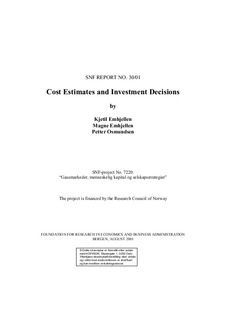Cost estimates and investment decisions
Research report

Åpne
Permanent lenke
http://hdl.handle.net/11250/164627Utgivelsesdato
2001-08Metadata
Vis full innførselSamlinger
- Reports (SNF) [542]
Sammendrag
When evaluating new investment projects, oil companies traditionally use the discounted cashflow method. This method requires expected cashflows in the numerator and a risk adjusted required rate of return in the denominator in order to calculate net present value. The capital expenditure (CAPEX) of a project is one of the major cashflows used to calculate net present value. Usually the CAPEX is given by a single cost figure, with some indication of its probability distribution. In the oil industry and many other industries, it is a common practice to report a CAPEX that is the estimated 50/50 (median) CAPEX instead of the estimated expected (expected value) CAPEX. In this article we demonstrate how the practice of using a 50/50 (median) CAPEX, when the cost distributions are asymmetric, causes project valuation errors and therefore may lead to wrong investment decisions with acceptance of projects that have negative net present values.
Utgiver
SNFSerie
Report2001:30